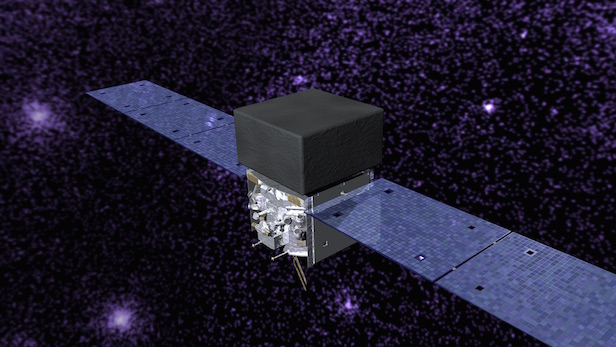Celebrating a decade of the Fermi Space Telescope
NASA’s Fermi Gamma-ray Space Telescope has been observing the most energetic events and objects in the universe for the past ten years

NASA’s Fermi Space Telescope has studied the extreme events and objects the cosmos has to offer. Image credit: NASA/GSFC/Conceptual Image Lab
The 11 June 2018 marks the ten-year anniversary of NASA’s Fermi Gama-ray Space Telescope observing the cosmos in an unusual light. Gamma-ray radiation is the highest energy form light exists in, and is unperceivable to the human eye. By observing gamma rays, astronomers can gain a better understanding of the most violent powerhouses in the universe, including black holes and neutron stars.
“Fermi’s first ten years have produced numerous scientific discoveries that have revolutionised our understanding of the gamma-ray universe,” says Paul Hertz, Astrophysics Division director at NASA Headquarters in Washington, United States.
The Fermi Space Telescope scans the sky every three hours, and its main instrument, the Large Area Telescope (LAT), has pinpointed over 5,000 individual gamma-ray sources. One of these sources is the explosion GRB 130427A, which is the most powerful gamma-ray burst ever detected.
The Italian-American pioneer in high-energy physics and Nobel laureate Enrico Fermi led the way in this field, and had this mission named after him. In 1949, Fermi suggested that cosmic rays, the particles travelling close to the speed at light, could be propelled by supernova shock waves. In 2013, Fermi’s LAT proved that gamma rays from stellar remnants are one of the sources of the cosmic rays.
Fermi’s all-sky map, drawn up by the LAT, revealed two massive structures extending above and below the Milky Way’s galactic disc. These two ‘bubbles’ cover 50,000 light years and supposedly originated from the supermassive black hole that resides at the centre of the Milky Way. They seem to have been produced only a few million years ago.
“The astronomy of gamma rays is the science of extremes,” says Julie McEnery, the Fermi project scientist at NASA’s Goddard Space Flight Centre in Greenbelt, Maryland, United States. “Extreme gravity, extreme magnetic fields – Fermi has opened a window on to some of the most interesting physics and structures in the universe.”
Fermi has another key instrument named the Gamma-ray Burst Monitor (GBM), and it can observe the sky at any time, except the section blocked out by the Earth. The satellite has observed over 2,300 gamma-ray bursts, which are the most luminous events scattered throughout the universe. These high-energy bursts occur when massive stars collapse or when neutron stars or black holes merge and emit jets of particles at nearly the speed of light. Within these jets, particles collide at high speeds and emit gamma rays in the process.
On 17 August 2017, a gamma-ray burst was emitted from a powerful explosion in the constellation Hydra. Almost simultaneously, the National Science Foundation’s Laser Interferometer Gravitational-wave Observatory detected the famous ripples in space-time from the same event, which was the merger of two neutron stars. This was the first light and gravitational waves detection from the same source. Fermi’s observations of gamma-ray bursts have also been used to confirm Einstein’s theory that space-time is smooth and continuous.
The GMB has also spotted over 5,000 gamma-ray flashes from Earth’s atmosphere associated with thunderstorms, as well as particles of antimatter those flashes can produce.
“Fermi has fundamentally improved our understanding of how the universe operates,” says David Thompson, a Fermi deputy project scientist also at Goddard. “This spacecraft has provided evidence for long-cherished theories and has also forced the scientific community to re-evaluate some of its assumptions.”
Working in space has been no easy endeavour; for instance, on 3 April 2012, Fermi narrowly avoided a collision with the defunct Soviet Cold War spy satellite, Cosmos 1805. Fermi’s team had to use the decommissioning thrusters to move it safely away from the former spy satellite. On 16 March 2018, Fermi experienced its first hardware failure when one of its solar panels became stuck. The Fermi team had to adapt a new observation strategy in order to work around the faulty solar panel, thus allowing the two main instruments to continue scanning the gamma rays of the universe.
“The Fermi observatory has so much flexibility that this glitch has only minor impact on science operations,” says McEnery. “Fermi is well prepared to continue operations for many years, and we look forward to many more discoveries about the high-energy universe.”
Keep up to date with the latest reviews in All About Space – available every month for just £4.99. Alternatively you can subscribe here for a fraction of the price!




